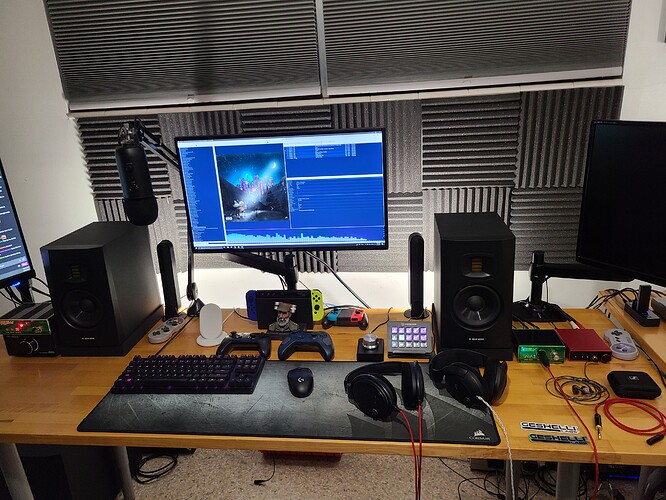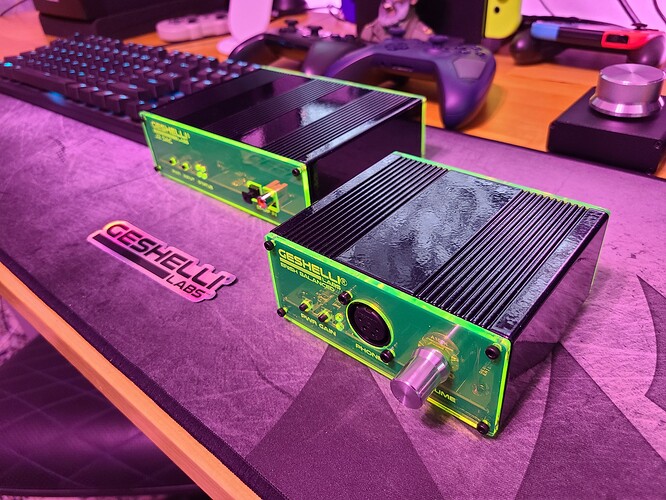A few people on this forum are using it with high-quality stuff. It’s hard to mess up a passive volume switch, so there’s not much to worry about. Especially if you choose one made of metal, which will get rid of all the possible interferences (from wifi, etc).
got the swtich and the Erish thx again
Hey nice, enjoy! 
Wait… I’m thinking about the switching and what switch did you get, and… the J2 outputs to XLR and RCA at the same time. Obviously, Erish is XLR to XLR, and Erish got its own volume. But for your monitors, you can just plug em via RCA, and get something like this for volume control.
Edit: Broken link? Amazon.com
no your advice was spot on
I currently use an E30/L30 stack in office and for the price-point i love it.
unfortunately my active speakers have a nasty ground hum from PC via E30 USB input.
with optical or a different (less noisy) source its whisper quiet with barely audible hiss with gain at max so i wanted to try a fully balanced setup since sub/monitors have XLR inputs
gave me an excuse to get erish and balanced cables for hd6xx (went with hart) hence needing that XLR switch.
so i will control volume with my virtual mixer Voicemeeter when i’m using monitors and Erish / L30 for headphones / IEM’s
I like to repeat this sentence lol but, you might want to use a volume control for your speakers instead if you don’t want to die hearing the Windows startup sound because of some random update or mishap. 
I can’t remember the last time I heard a windows startup LOL but voicemeeter jacks the audio and takes about 3-5 seconds to start its engine so even if there was a loud tone it would either play to nothing or voicemeeterr which i can set lower
I really really wanted a fancy pants balanced dac with pre-amp for volume control but I wasn’t impressed with anything under 1K due to either support, reliability or just plain value for price.
D30Pro and D90SE were on my short list but they were just a bit overpriced IMHO
and since i ONLY use the active speakers with PC volume control isn’t an issue
This might also be doing a disservice to the J2 to use digital volume control…
I mean, you’ll hear with your headphones how good the J2 sounds, with digital volume at 100%. But I heard lately that when the digital volume isn’t at 100%, the sound quality isn’t at 100% either.
There’s no way for a computer to lower the volume of a digital signal without “destroying it” a little bit (pun not intended). When you lower the volume, you actually lower the bitrate of the music, because it’s the only way to “lower” the “volume” digitally.
To be honest, I never heard a difference… Smartphone + IEMs never sounded “imperfect” to me and my volume is obviously never at 100% – and my music definitely did not sound like a Mario Bros. 8-bit song either, lol. So it’s not that bad, but it’s another good reason (or excuse  ) to get a passive volume thingy, one day.
) to get a passive volume thingy, one day.
ok a couple of things since you raise good points. I’m no expert either but this is what I’ve read
yes technically lowering digital volume within windows lowers bit DEPTH i.e. dynamic range. so in simple terms it compresses the sign wave losing amplitude (volume). it differs from an amp pot in that it only lowers the signal, not the noise floor, unlike an amp that lowers both.
this is where up-sampling comes in. simply up-sampling to 24-bit depth gives you the “head-room” to lower volume several DB and still be well above the 20 or so bit-depth that most amps can actually physically represent. remember dynamic range from source vs what an amp can actually reproduce aren’t usually the same. some DAC’s automatically up-scale to avoid aliasing with volume adjustments etc.
which leads to the J2. it has Hi-Low gain no? how do you think it does this in digital? or analog? bottom line is if your not a purist about up-scaling its kind of a non-issue.
voltage also has a lot to play with my IE300’s for example on phone even at max volume they sound just fine but on L30 its easy to go too far and it gets very bright fast… still sounds great at normal volumes but the phone sounds way more relaxed probably due to much less power
at least its what I’ve observed
Unless the amp has a somewhat exotic volume control, changing the volume should not affect the noise floor (except near the maximum).
maybe i could word that better… an amplifier by nature amplifies both noise and signal so that they stay relative to each other meaning your noise floor goes down with the signal voltage.
in the digital realm volume only affects the signal, the noise floor is constant so the lower u attenuate digitally the closer you get to DAC’s noise floor…
mostly academic i don’t think its typically audible since lower volumes are less detailed anyway 
Update: I did finally upgrade from E30/L30 to Geshelli JNOG2 / Erish (still have L30 for SE IEM’s)
using XLR’s with balanced DAC COMPLETELY solved all of my GPU whine and ground loop hum.
I couldn’t be happier and this is the best example IMHO of a reason to actually use a balanced setup casually on a desk. (vs. professionally in studio)
The relationship between noise and gain in amplifiers is not as direct as people may think. I would look at the Friis formula for an initial look at this topic.
Also, nice setup! May I ask what is this beautiful knob left to the Elgato streamdeck?
Since I compromised on a DAC without Pre-Amp functionality I wanted a convenient way to control volume for Voicemeeter (my mixer).
I use the JNOG2 with its 3 Gain stages for 3 max volumes from which i may minimally lower depending on source. it works.
I also use stream deck for foobar / VM control but the knob is very convenient and you can re-program for literally anything.
https://www.amazon.com/gp/product/B01MV411BR/ref=ppx_yo_dt_b_asin_title_o01_s00?ie=UTF8&psc=1
Thanks! The Geshelli Gear matches my PC perfectly too bad its in my closet ![]()
While that was very interesting to read I think it only further supports my claim that lowering analog volume at the amplifier stage will reduce noise with signal (exponentially is your point?)
which is probably why the safest answer is usually to have a digital signal at max volume (below clipping point) since its noise-floor is constant up until it reaches analog output @DAC
since an amplifier raises noise exponentially with a signal if I read that formula correctly?
Not exactly. If look at the formula, you will see it’s a sum, not a multiplication like a traditional gain. Noise along a signal chain is added by each component, it isn’t amplified along side the signal. If it did, the Signal-to-Noise Ratio would never change, since you’re amplifying both equally. What the formula means is that, when you have multiple amplifiers, the one that influences the more is the closes to the source, not necessarily the one with the highest gain. Typically, you would then make a lower noise amp in the input and have a noisier but controllable amp in the output, and it shouldn’t influence the noise in the chain that much.
Sorry if it was too technical, just trying to bring a little more info. Also, this loop with the Geshelli duo really shines. Maybe getting something a little lighter for the fluid and it would be a perfect match, something like the EKWB Neon Green. Put the pc somewhere it can be seen, with the duo on top of it and you have a full house.
ohhh thanks for the explanation! with that in mind maybe a pre-amp someday would be worthwhile but hard to justify atm!
as for PC its a full EK loop i built back in 2016 or so and yes its the Neon Green in there now just go rid of the LED strip in the case a while back when i moved it into my closet. the closet uses a 140mm case fan to fent into a hallway closet because with 2 radiators and everything OC’d it generates some heat! I’m over showing off my PC its fun to hide it now then wow someone that’s like where is PC?
edit: i was wrong its the EK CRYOFUEL Acid Green crap! u were right again! 
I would have thought the same until early this year when I dipped my toes into analogue circuit design. Aspects such as ripple from the PSU section change depending on load of the amplifier section, Bias voltage (and the current it can cause) ads some noisefloor, etc.
It is a complex subject and one that does not allow for blanket statements (at least not for ones that have some truth to them).
Edit:
If you want a stunning example of this:
Timestamped:
Ok. I’ll always prefer analog controls (…for analog audio), but this is the next best thing. ![]() Congrats, glad everything works well and the distortion is gone!
Congrats, glad everything works well and the distortion is gone!



